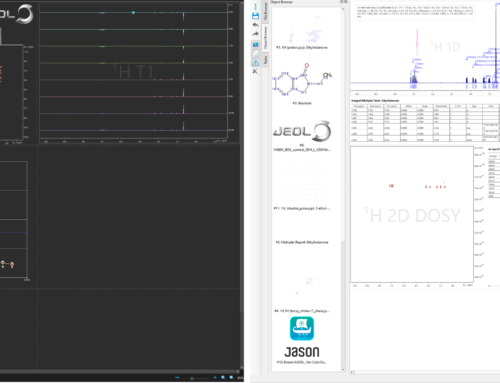Introduction
In this post, I would like to convince you that JASON software allows you to process NMR data of liquid and solid samples with ease and that you can get high-quality figures for your reports, scientific articles, theses or patents. Why should you care? Solid-state NMR spectra contain information which may be unaccessible from solution NMR spectra and other analytical methods. Indeed, it is easier and more comfortable to process all NMR data using a single software than using two or even more different software packages. In addition to that, JASON software is a modern and affordable software.
Processing of solid-state NMR data with JEOL JASON software
If you have not seen and used JASON software yet, you might be interested in watching this webinar or downloading JASON software. If you have already processed your solution NMR data with JASON software and enjoyed its open canvas and other exciting features, you may ask yourself whether or not JASON could also process and visualise your solid-state NMR data. The answer is YES. Solid-state NMR data are not that different from solution NMR data. This is not perhaps surprising, because they can be collected on the same instrument. Signals of solids are usually broader, and hence the splittings due to J-couplings are not typically visible in the spectra of solids. However, the most common solid-state data, such as MAS (Magic Angle Spinning), DDMAS (Dipolar Decoupling MAS) or CPMAS (Cross-Polarization MAS), require Fourier transformation, zero filling, apodization, phase correction, baseline correction and other operations common to liquids. There are some ‘advanced’ solid-state NMR experiments and applications that may require special processing functions like shearing in MQMAS (Multiple-Quantum MAS) data processing. However, while some of these functions are not yet in JASON, we are continuously working on implementing new functions and tools.
Now I am going to show you examples of routine solid-state NMR spectra processed with JASON. All the spectra were collected under MAS conditions on a JNM-ECZ500R spectrometer equipped with a 3.2 mm AUTOMAS probe. MAS typically gives rise to a series of spinning sidebands. The purpose of MAS is to increase resolution and sensitivity by suppressing the anisotropic interactions present in solid samples. I will not go to details in this post, however, an interested reader could find more in this book [1].
Proton MAS spectra of solid samples
A proton (1H) MAS spectrum of L-tyrosine hydrochloride is shown in Figure 1. Although the sample was spun at 19 kHz, which is a rate nearly 1000-times larger than the spin rate common in solution NMR, the signal is nevertheless very broad, and hence individual peaks cannot be observed even on such a simple organic molecule. This phenomenon is often observed in the spectra of solid samples. There are special techniques to enhance resolution in 1H MAS spectra, but they will not be discussed in the post. In addition to the ‘isotropic’ signals in the middle of the spectrum, we also observe a series of spinning sidebands separated by exactly 19 kHz either side of the isotropic peaks, indicated with asterisks.

Figure 1. 1H MAS spectrum of L-tyrosine hydrochloride collected at 19 kHz MAS.
Carbon CPMAS spectra of solid samples
A carbon-13 (13C) CPMAS spectrum of L-tyrosine hydrochloride is shown in Figure 2. The spectrum was also collected at 19 kHz MAS; however, in this case very strong proton decoupling was applied during the data acquisition to suppress heteronuclear dipolar interactions. The proton decoupling was far stronger than the decoupling used in solution NMR, because the dipolar interactions are much stronger than the scalar interactions present in solution. Please note that, in contrast to the 1H signals in Figure 1, the 13C signals are narrow and resolved. This is the reason why 13C NMR spectra are usually more popular and useful at moderate MAS spin rates than proton spectra of solid samples. The series of small signals on the right-hand side are spinning sidebands, again indicated with asterisks.

Figure 2. 13C CPMAS spectrum of L-tyrosine hydrochloride at 19 kHz MAS.
MAS spectra of other nuclides
Figure 3 shows a 79Br MAS spectrum of potassium bromide (KBr) collected at 5 kHz MAS. The intense peak in the middle is the isotropic peak, indicated with a circle, while all the other peaks are spinning sidebands. KBr plays a special role in solid-state NMR. This standard sample is used to adjust the Magic Angle on, and hence solid-state NMR researchers collect and process 79Br data of KBr very often.

Figure 3. 79Br MAS spectrum of KBr at 5 kHz MAS.
Conclusions
In this post, I have shown you a couple of examples of solid-state NMR data processed with JEOL JASON software. I have also tried to briefly explain how solid-state NMR spectra differ from spectra of liquid samples. I hope I have been able to demonstrate that JASON handles solid-state NMR data with ease just like spectra of liquid samples. It is a great advantage to be able to process solution and solid-state NMR data using one software package.
Why not try JASON software for yourself? Discover how its advanced data processing and analysis tools make it easy to get great results from solid-state and many other NMR datasets.
If you wish to know more about JEOL ECZ Luminous NMR spectrometers and solid-state NMR probes, click the links. A brochure on JEOL solid-state NMR is available here.

